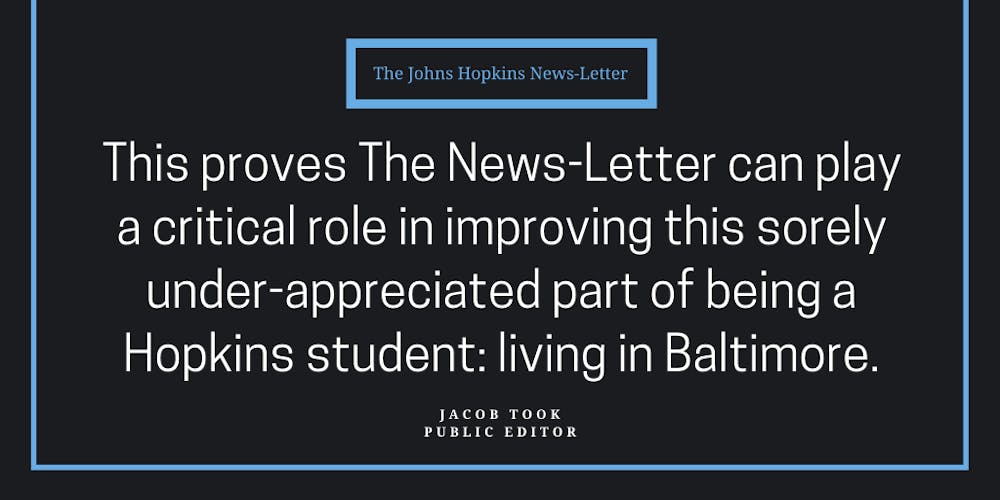
You’re a Hopkins student.
You wake up, and if you’re not already on campus you’re probably no more than a few minutes away. You grab coffee and a croissant from Brody Cafe before class. You catch the JHMI, which ferries you across Baltimore to the Hospital’s doorstep. You’re in the lab, head bent, back aching for hours. You head back to campus, hit up the library and then the rec center. You grab dinner at the FFC or, if you’re feeling adventurous, somewhere along St. Paul, on your way home.
The next morning, your alarm jars you awake, and you do it all again.
This is the Hopkins bubble. It’s not a line on a map, it’s not a physical barrier we put up around campus. It comes about when we keep our heads down, buried in our work, closing ourselves off to anything new because our minds are operating at capacity and the idea of yielding headspace to any new thoughts triggers an automatic panic mechanism.
It’s easy for the rhythms of a busy semester at Hopkins to lull us into moving through life on autopilot. It’s easy to not notice as the weeks fly by like this, until you’re left wondering whether you went to brunch in Hampden three or four weekends ago, and whether you’ve been off campus at all since then.
Last week I responded to a piece in Your Weekend which opened up larger questions about how editors should account for the fraught history and dynamics between Hopkins and Baltimore. Before tackling this question, though, some editors are starting smaller. This year’s Arts & Entertainment Editors, for example, have been shifting their content to showcase the different ways students could connect with Baltimore through their interest in arts.
“Being a student at Hopkins, you’re a resident of Baltimore for four years, so it’s very important that you understand the community you’re living in. That requires you to go out, that requires you to meet people,” Arts & Entertainment Editor Katy Oh told me. “That’s an integral experience of being a student on campus.”
Oh hopes that a shift toward more event-based coverage, with less of a reliance on album, movie and other media reviews, would help connect students with more opportunities to get off campus and tap into the Baltimore arts scene.
“Students here are unable to attend a lot of local events by themselves, and if they’re not getting information about local events, then they’re more and more disconnected,” she went on to add. “The medium of The News-Letter is providing that connecting outlet.”
Oh and her co-editor Jae Choi have been encouraging their writers more and more to report on local arts events. They pack their budget — the list of articles planned for a given week — with local events, hoping that at least one will catch the interest of each of their writers. But they still face challenges.
Choi, who joined The News-Letter as a staff writer for News & Features and was an Assistant News & Features Editor last year, explained that many Arts writers may be uncomfortable writing in a more journalistic style and simply aren’t used to reporting. Finding audience members to interview after an event can be a challenge for seasoned reporters, and much more so for someone just cutting their teeth.
“Don’t be afraid of approaching people,” Choi said, listing a common piece of advice he offers writers before they venture out on their own to report back.
“I think, more so than news, people at arts events are usually a bit more comfortable, especially if it’s not something terribly controversial,” he added, and then recalled with a laugh, “I’ve been to some protests where people were very much trying not to talk to me.”
Choi said that shifting to more event coverage was important for him personally because it was this type of local reporting that first stoked his passion for The News-Letter and led him to get more involved. He wants to share that experience with more writers, and explained that connecting them with more opportunities to explore would also help the section feel tailored to readers in Baltimore, which he hopes will increase readership.
That being said, Oh emphasized that they are seeking a balance. There’s a valid defense of reviews: they are usually soaked in the writer’s voice, often engage with pop culture trends like popular binges or much-buzzed-about movies, and reflect the things Hopkins students are thinking about, which fits nicely in with the paper’s mission of representing student perspectives.
Looking broadly at last semester, the section was split roughly evenly between media reviews (about 46 percent of articles) and event-based coverage (about 40 percent). About half of that 40 percent was arts-related coverage on campus, while the other half consists of writers reporting back from various local venues, exhibitions and other hot cultural spots.
They’re on the right track — only two of last week’s seven articles were reviews. If Oh and Choi keep media reviews to fewer than half of each weekly budget, they’ll soon see reporting from local events take over as the majority of the section’s coverage.
Given the challenges their writers face, though, that may be easier said than done. Oh and Choi can offer concrete resources that explain the basics of reporting — Choi recalled the News & Features Editors sharing guides to conducting interviews and other basics with their staff. These documents should be integral to any section that expects hands-on reporting from its writers.
Some writers might resist, and if their hearts are really set on writing reviews, then let them keep writing reviews, and I’ll keep reading.
But those who do take up the suggestion to get off campus may be very glad they did. For writers who want to take this step but aren’t sure how (or are understandably nervous), Choi and Oh could pair them with more experienced reporters or offer to go with them to events to demonstrate how it’s done. Once they get started, they won’t want to stop — Oh affirmed that writers who start reporting locally often have a surprisingly good time.
This proves The News-Letter can play a critical role in improving this sorely under-appreciated part of being a Hopkins student: living in Baltimore. By highlighting the diversity of worthwhile stories playing out right in our neighborhoods, The News-Letter can pop students out of their reverie, offer examples of how to engage with their local community and get their minds (and hopefully their feet) off campus somewhere new.
We want you to be part of this conversation! We encourage our readers to email publiceditor@jhunewsletter.com with questions or comments about our practices and published content.





